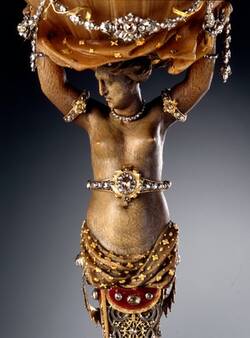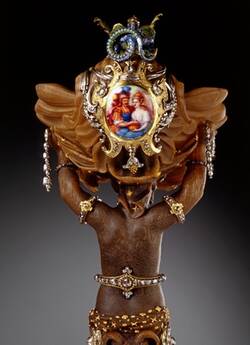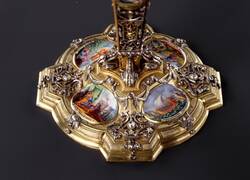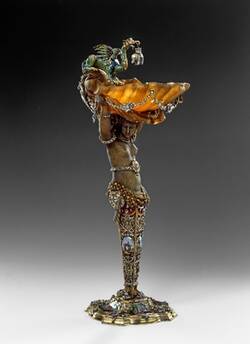August the Strong paid his court jeweller, Johann Melchior Dinglinger, three thousand thalers for this bowl, with a female Mohr forming the stem. It is an example of Dinglinger’s entrepreneurial courage. He frequently produced objects without first receiving a commission, which made him dependent on August the Strong’s favour and ability to pay.
The female figurine was carved by Benjamin Thomae from a single piece of precious rhinoceros horn. The dark colour of the horn is the reason the figure was at some point known as a Mohr. She is supporting on her head a bowl reminiscent of a fan-shaped scallop shell. It’s also made from rhinoceros horn, and has silver garlands, studded with diamonds, fastened to it.
The figurine’s gold mount is by Johann Melchior Dinglinger; the enamel painting on the stem and foot of the bowl are by his brother, Georg Friedrich. The small medallions illustrate scenes from the ancient Greek saga of the Argonauts. Around 1709, when this bowl was produced, the tale of how the Argonaut Jason, with the help of the magician Medea, stole the Golden Fleece and took it to Greece was highly relevant.
The background was a visit to Dresden by King Frederick IV of Denmark. August the Strong tried to impress his cousin with extravagant festivities and win his support for a new alliance against Sweden. This bowl contains numerous allusions intended to encourage the Danish king to support August the Strong’s enterprise. For instance: the little white enamel elephant, which the dragon is presenting at the tip of the shell. It’s the badge of the Danish Order of the Elephant.
August the Strong was related to the Danish royal family through his mother. He was a knight of this order and wore the badge – it is reported – on “special occasions“.
Weitere Medien
- Material & Technik
- Rhinozeroshorn, Gold, Silber, Email, Diamanten, Barockperle
- Abmessungen
- H 37,0 cm, B 12,7 cm, T 15,3 cm, Fuß: B 12,5 cm, T 12,5 cm
- Museum
- Grünes Gewölbe
- Ort & Datierung
- Dresden, um 1709
- Inventarnummer
- VI 119



